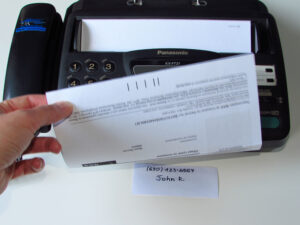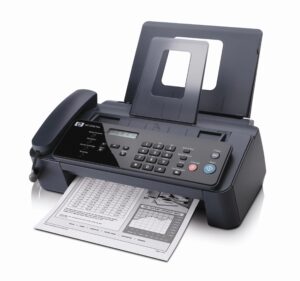Back to: Computer Science Primary 2
Welcome to class!
In today’s class, we’re going to journey into the world of ICT devices and explore a fascinating piece of technology – the fax machine. While fax machines have been around for quite some time, they play a unique role in the world of communication. Let’s delve into a comprehensive exploration of the uses and functions of fax machines.
ICT Devices – Uses of Fax Machines
Understanding Fax Machines

A fax machine, short for “facsimile machine,” is a device that allows you to send and receive documents and images over long distances using telephone lines. Think of it as a digital messenger that can transmit written or visual information from one location to another.
An in-depth look at the uses of fax machines:
Document Transmission: The primary use of a fax machine is to send and receive documents. Whether it’s a contract, a letter, a report, or any piece of paper, fax machines can quickly transmit them to another fax machine at a distant location.

Image Sharing: Fax machines can also send images, such as diagrams, charts, and photographs. This is useful for businesses and organizations that need to share visual information.
Signature Verification: Fax machines are often used to transmit signed documents. This is essential for legal and business transactions, where a physical signature is required.
News and Information: In the past, fax machines were used by news agencies to transmit news articles and updates to subscribers. While email and digital platforms are more common today, some still use fax for this purpose.

Forms and Applications: Fax machines are employed for sending forms and applications, such as job applications, insurance claims, or medical records. This can save time and ensure the prompt processing of paperwork.
Healthcare: In the healthcare industry, fax machines are used to transmit patient records, test results, and medical documents securely. It’s a critical tool for ensuring patient confidentiality.
Email to Fax: Some fax machines have the capability to convert emails into fax documents and send them to a recipient’s fax machine. This bridging of digital and analog communication is known as email to fax.
Secure Communication: Faxes are considered more secure than email for transmitting sensitive information because they don’t rely on the internet. This is why many legal, financial, and government institutions still use faxes for certain communications.
International Communication: Fax machines allow for international communication without the need for complex translation or language barriers. Documents are sent as they are, overcoming language differences.
Storage and Archiving: Faxes can be used for creating physical copies of documents that may need to be stored or archived in a paper format.
While fax machines may seem old-fashioned in the digital age, they continue to be used in various industries for their unique ability to send documents securely, with a physical signature and without the need for an internet connection.
In conclusion, fax machines are a special piece of ICT equipment that serves as a reliable means of transmitting documents, images, and information across distances. They have found their place in industries where security and signature verification are crucial, and they remain a relevant tool in the ever-evolving landscape of communication technology. The next time you encounter a fax machine, remember its unique role in bridging the gap between physical and digital communication.
Question Time
- What is the primary function of a fax machine, and how does it differ from other forms of document transmission?
- In what situations might you choose to use a fax machine to send documents instead of email or regular mail?
- How do fax machines handle the transmission of images, and can you give an example of when this feature might be useful?
- Explain the role of fax machines in signature verification, and why is this function important in legal and business contexts?
We have come to the end of today’s class. I hope you enjoyed the class!
In the next class, we shall be discussing Parts of Common ICT Devices.
In case you require further assistance or have any questions, feel free to ask in the comment section below, and trust us to respond as soon as possible. Cheers!
